Lockwood Custom Optics at the Chiefland Astronomy Village and the 2009 Winter Star Party
My 20" f/3 heads south and stops a few places to bask in the Florida sunshine and starshine.
All images and text Copyright Mike Lockwood, 2009
After a two-day drive, John Pratte and I rolled into the Chiefland Astronomy Village on Tuesday afternoon, Feb. 17. I decided to set up the 20" F/3 near Charlie Warren's 20" F/4.3 Starmaster, and we made camp and set up the telescopes. Setup and collimation were uneventful, and I was becoming proficient using the autocollimator, even tweaking primary adjustments by myself. I took a shower, and we readied ourselves for the night's observing. Tom Clark stopped by to see the ultra-short 20" telescope.
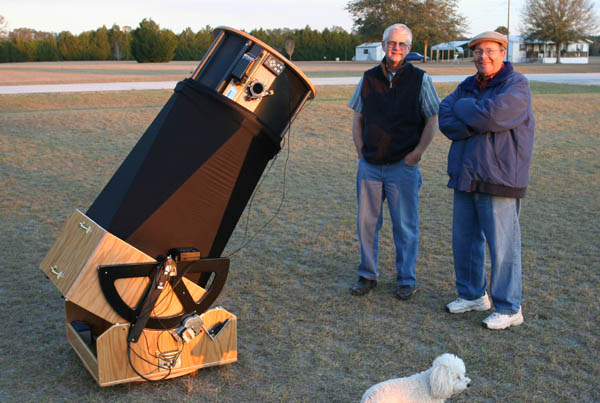
John Pratte (left) and Tom Clark give scale to the 20" MX telescope as the sun sets. Note the Floridian wearing a jacket and hat, I guess 68 degrees is a little chilly.
The first night of observing yielded a clear, dark sky, and we quickly had fun observing Sirius, barely spotting the Pup, and then moving on to M42, M46, and various other objects. Charlie, Tom and other neighbors stopped by to see the 20" MX, and they enjoyed seated observing. The immediate verdict, after a small tweak of collimation, was that the 20" MX was up to the task of being used under much steadier Florida skies. Saturn was looking fairly good as it rose.
We had gotten in a good bit of observing before Tom stopped by again and invited us to check out his 42" telescope. He had just finished entertaining a group of visitors. We enjoyed the bright views that this huge telescope can provide, in a dome sheltered from the wind on this cool evening. Soon afterward we went to sleep, pleased with our observing experiences.
Arrival of an FX
After a good night's sleep, we had breakfast and were standing around when a pickup truck pulling a cargo trailer pulled into the driveway. Out stepped none other than John VeDepo. His page about imaging and video astronomy is found here (on the articles page of the Starmaster web site).
So, with John's 16.5" FX Starmaster set up, at sunset the next day I decided to get some photos of Charlie, John and I with our telescopes.
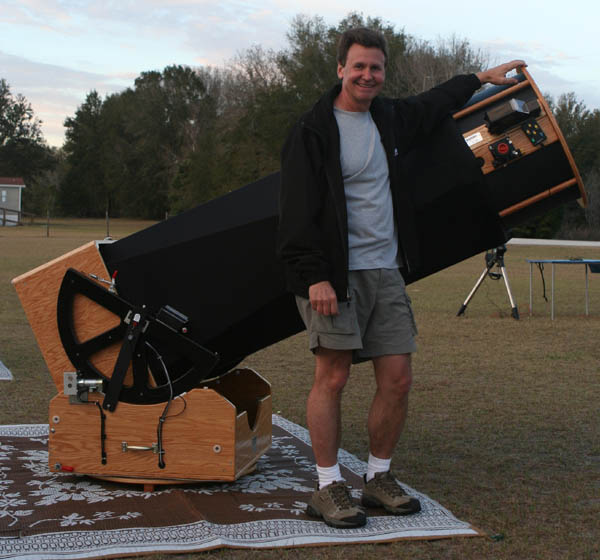
Charlie Warren and his 20" F/4.3 Starmaster, with superb Zambuto optics.
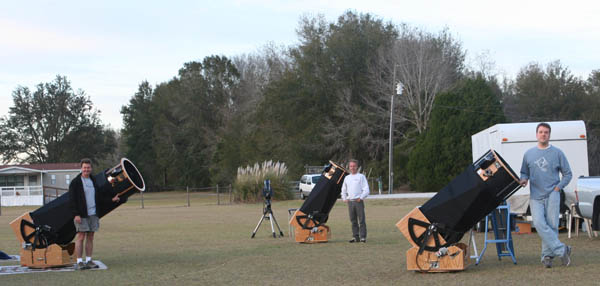
Charlie Warren (left) with his 20" F/4.3, John VeDepo (middle) with his 16.5" FX, and myself (right) with my 20" F/3 MX. Note that John is not tall, but he's not that short! He's the farthest away, Charlie is closer, and I am the closest (no, I'm not some sort of giant). We all gave each other plenty of space, because there was plenty of space (unlike WSP).
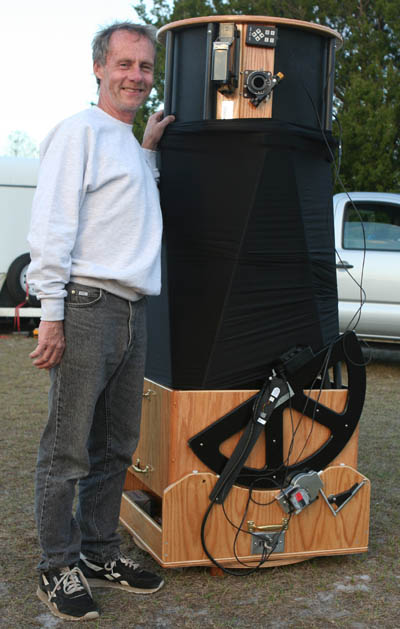 Clouds
arrive
Clouds
arrive
John VeDepo is shown at right with his 16.5" FX telescope. Notice how perfect the eyepiece height is for him with the scope pointed at the zenith.
Wednesday dawned with increasing clouds, and soon it was overcast. John had planned to use the MallinCam in his 16.5" and the 20" MX, but it looked like mother nature would thwart that plan. We hung around the field, then John P. and I went shopping to get some food and lunch. We sat around, hoping for clear skies, but it was not to be.
For dinner we went to a local restaurant and I had all-you-can-eat fish. What else could I do having just come from Illinois in February? As it became clear that the sky was not going to clear, Tom invited us to his house for an evening of interesting and spirited conversation.
I slept well, but woke up to a morning storm. My tent mostly stayed dry, as did all of the telescopes, safely covered. The rain stopped as we had breakfast, and the clouds began to break. Bands of clouds moved from the west periodically, and little did we know that this would continue nearly all of the next night.
As darkness fell John set up the Mallincam, but that task was made difficult by passing bands of clouds that rendered M42 invisible every few minutes. It was the beginning of a night of frustration, but one which eventually yielded some nice views of deep sky objects. We eventually imaged the Sombrero (M104) in the 20" with the MallinCam, and that showed that the camera could be used in an F/3 telescope with the focal plane positioned normally. Charlie Warren found Comet Lulin early on Friday morning, and that was about the last view I enjoyed before turning in, tired and a bit frustrated by the weather.
Off to the Keys
Following a few days at a friend's on the east coast of Florida, we headed for the Florida Keys and the Winter Star Party. We arrived Monday afternoon and managed to shoehorn our way into a campsite and find space on the berm for the 20" f/3 MX. The 20" spent its days covered with a shiny cover that was a bit too large, but which did the trick. Here's a photo of the covered telescope and a photo that helps convey the atmosphere of the Winter Star Party.
Covered FX telescope on the berm (left) looking like a fat cannon wrapped in mylar, and a nice palm tree (right, obviously) to get the feeling of what the Winter Star Party is all about for us northerners.
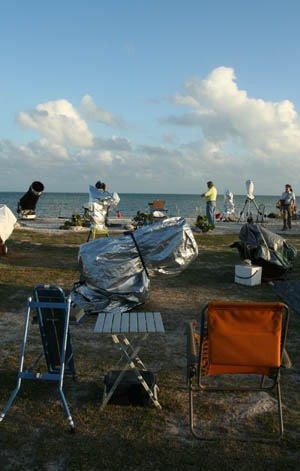
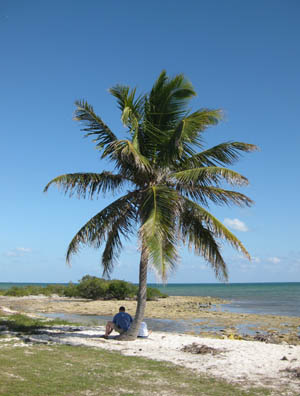
Six days, five nights
Well, what can I say - it's all a blur and I hardly drank any beer. From 7pm to 1am on Monday-Friday nights, it was the '20" F/3 MX show'. A line formed at the telescope at dusk, and disappeared and re-formed throughout the night. Breaks were taken to get hot cocoa, soda, brownies that literally just came out of the oven, and to use the facilities. But, mostly, I was with the telescope showing people things like Sirius and its companion, the Pup, which was very, very, very easy to see. M42 and M46 were my favorite showpiece objects, garnering many an "ooh" and "aah" from those who saw them. The evenings passed quickly.
Some specific recollections include Vic Menard's first look through the telescope. After we discussed and tweaked collimation, he sat down, looked at a star field and said "Frickin' incredible!" Can't say it much better myself, Vic. I'm still stunned how well the telescope performs at F/3 with the Paracorr and Ethos eyepieces, and Naglers at high power.
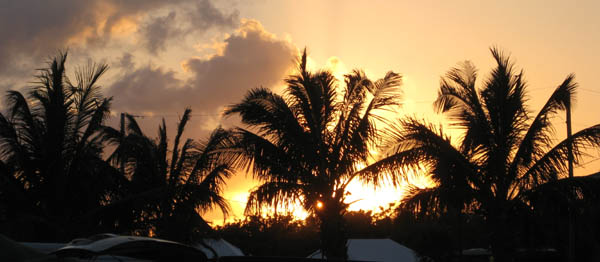
The sun sets over West Summerland Key, and over my trip to Florida. Shortly after this sunset the moon and Venus looked spectacular in the excellent Florida seeing conditions.
So what did I learn? Well, here it is, in a few paragraphs.
First of all, this telescope keeps up with any other telescope of similar size, without a ladder. Views of deep-sky objects were similar to those in similarly sized scopes. It was the planetary images that truly impressed me. Saturn looked spectacular when the wind and seeing calmed down. Many others agreed, and we watched six moons dance around it on one particular night. The colors on the planet's disk were quite apparent, and you could easily look through the gap in the rings. It simply exceeded my expectations for planetary images.
Collimation held well all week. I touched up the primary collimation on a couple of occasions, but that was at most a 1/4-turn of a collimation knob. Collimation held nearly perfectly from zenith to near the horizon, proving the rigidity of the Starmaster structure and mirror cell. I was extremely pleased. Omega Centauri looked spectacular the couple of times it popped out between clouds and haze in the southern sky, as did Eta Carina and Centaurus A.
Sirius B was a piece of cake most nights. Stars were fairly sharp to the edge of the field even with the 17mm Ethos, Paracorr set all the way in. The mirror showed excellent correction so long as the Paracorr was set properly for the eypiece that was being used. Star testing showed a smooth mirror with generally good correction, so I was a happy optician.
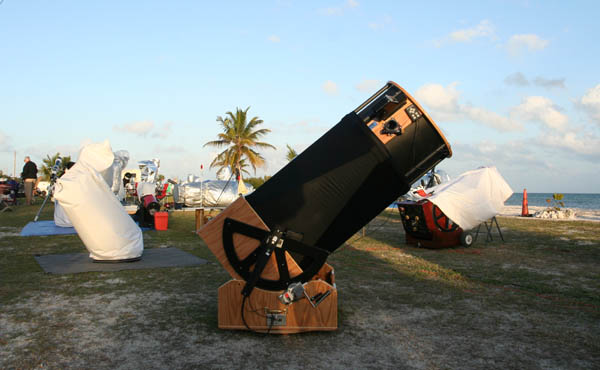
The 20" f/3 MX telescope ready for an evening of observing.
The moon and Venus looked absolutely amazing as they set, close to each other on Thursday evening, I believe it was. Numerous observers enjoyed the entire disk of the moon, in razor sharp detail, in a 13mm Ethos eyepiece. I stared for a long time at the tiny lunar features visible due to the long shadows and the excellent seeing conditions. Venus was very large and very sharp, by far the best view I have ever had. The edge of the crescent was razor sharp when the seeing permitted. It was simply a spectacular pairing.
The Paracorr 1 is clearly near its limits at F/3. This is absolutely no surprise. The moons of Saturn showed a little distortion as they got farther from the planet, but this is to be expected when pushing the envelope. However, no one had anything but amazement to share with the view of Saturn, and many rated it above views provided by other telescopes. They just couldn't believe they were looking at Saturn, while seated, through an F/3 telescope!
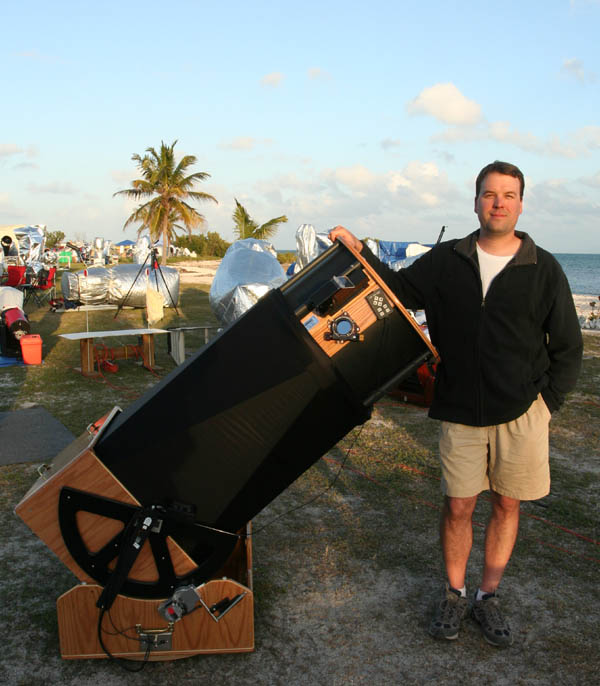
The 20" f/3 MX telescope and me, ready for an evening of observing.
Clear, dark skies, warm weather, good friends, and good seeing.
-Mike Lockwood, Lockwood Custom Optics